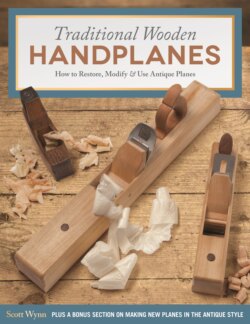Читать книгу Sew-It-Yourself Home Accessories - Scott Wynn - Страница 13
На сайте Литреса книга снята с продажи.
HANDLES
ОглавлениеLarger planes are fitted with handles or “totes.” These can be either open or closed, though functionally it makes little difference to the hand. The closed tote is perhaps a bit stronger, though if you’re pushing hard enough to break one of these handles, you’re working too hard! It may make it easier to pick up a larger plane for the return stroke as the larger planes almost always have a closed tote. The older planes are usually meant to be used with a three-finger grip, so they may be a little small for the modern hand or someone who prefers a full grip. Modern versions usually are larger and meant for a four-finger grip.
The larger planes also no longer have a front handle. Moxon depicts a bent-over curlicue of a handle that I could never figure out and have never seen an example of, even in a museum, but such a handle has not been used for at least 300 years, so it must not have been very effective. Occasionally, longer Scandinavian planes would be fitted with a horn or variation of the horn handle up front, similar to those they used on their shorter planes, but this is also uncommon now.
Figure 1-12. Horned Plane with a Lignum Vitae or Hornbeam Sole
The bigger planes are intended to be used with the forward hand gripping the block cross-handed with the thumb toward the user, though they can also be used with the hand on top, the thumb on the far side of the plane. You can see long planes in the Tool Museum (Maison de l’Outil) in Troyes, France, where the block is worn to the shape of the forward hand and its thumb, and while perhaps some of these may have been shaped, it is believed that this is a result of wear. One of the planes is nearly worn through where the thumb would be (you can see light coming through!). That’s a lot of time spent holding on to that plane.
Northern and Eastern Europeans developed the “horn” for the forward handle on their shorter planes, the back of the block nicely rounded to fit the whole of the hand with a thumbpiece to keep your hand from riding up and chafing on the blade. I like this plane a lot for heavy work. I think the horn is a successful design (Figure 1-12).
While the cross handle today is most widely used on planes from Asia, antique examples from Europe can be found, particularly on two-man planes and larger one-man planes. It’s a pretty effective grip that can apply a lot of downward pressure, necessary for very hard woods, though this power dissipates pretty quickly the further you lean out as the stroke progress. Again, it is better to have the work in front of you than to one side, but it’ll work in that position too.
Figure 1-13. Traditional Smoothing Plane of China and Southeast Asia
ANATOMY OF THE HORNED PLANE
Horned planes commonly come with 45° or 50° blade angles. I believe they were also made with 43° and 47.5° blade angles. Prep planes such as scrub planes sometimes have a 40° pitch; some finish planes have a pitch above 50°. A toothing plane is made with a 70° pitch. Check with the distributor if you are looking at new planes, or take a protractor to the flea market.
On premium models, the mouth opening adjusts with a movable mouthpiece (the reform plane). Chipbreakers are substantial and well-made, though some may require some refinement to function with a finely set mouth.
Primus planes use a traditional approach to bedding the blade by having it contact the bed at just its bottom and top. To do it, they have installed two metal buttons at the top of the blade bed to suspend the blade so it contacts the bed only at these points and at the bottom. This guarantees the blade is supported at the heel of the blade bevel, the most critical area for eliminating chatter. Though the blade and chipbreaker assembly bridges this distance, this assembly, further dampened by the tension rod which holds this assembly and is part of the adjustment system, is thick enough that the blade does not chatter.
The blade placement is a little more central than Bailey-style planes and most traditional wood planes, the blade edge being back from the leading edge of the plane about 40% of the length of the sole. This slightly more central position makes it a little easier to begin and complete a planing stroke.
The horn is available in both right- and left-handed versions.
